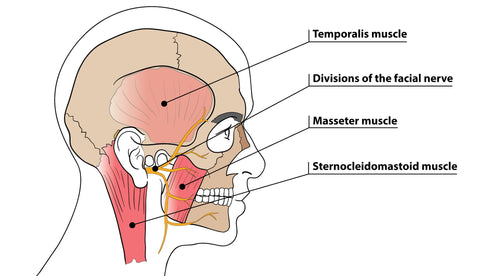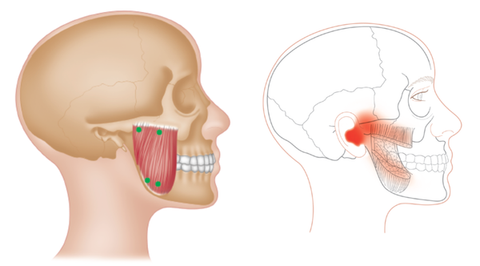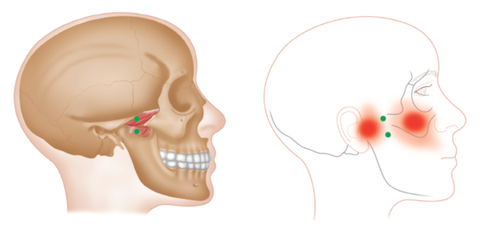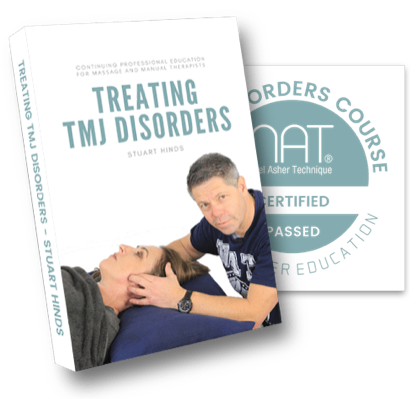Treating Temporomandibular Joint Disorders (TMJ / TMJD)

It is estimated that 20–30% of the adult population will have TMJ problems at some point in their life
TMJD disorder is sometimes called the ‘Great Impostor’ because of the multiplicity of symptoms.
Pain, stiffness, clicking, clunking or popping sounds, and aching in the jaw muscles characterize this debilitating problem.
Classically the headache is strongly felt in the region of the ear.
Types of TMJD's
Temporomandibular joint disorders (TMJD's) are problems affecting the joint between the lower jaw and base of the skull.
There are two temporomandibular joints (TMJ's), one each side of the jaw, that allow the mouth to open and close. These are gliding joints.
There are two types of TMJD's: muscle-related TMJD, which is the more common form, and joint- related TMJD, and these conditions can often coexist.
While it is not a serious condition in terms of it being a threat to life, it can have a serious impact on health.
It is estimated that 20–30% of the adult population will have TJD problems at some point in their lifetime.
Treating TMJ Disorder with Cupping - Vicki Ramsdell

Common Causes
Muscle-related TMJD's are more commonly caused by clenching the jaw and nighttime teeth grinding, which overworks the jaw muscles and puts the joint under pressure.
Joint-related TJDs are caused by degenerative joint disease, rheumatoid arthritis, ankylosis, dislocations, infections, or tumors.
Joint TMJD's typically lead to a popping or clicking of the jaw joint, the jaw locking, pain at the side of the jaw joint (usually one sided), and headaches.
Muscle TMJD will lead to pain on both sides of the jaw joint, headaches, and a difficulty opening and closing the mouth.
Additional Symptoms
In addition, any of the following symptoms may also be present: pain in the shoulders, back, or neck; tinnitus (ringing in the ears); dizziness; blurred or double vision; vertigo and nausea; hearing problems; and pain in front of the ears.
Treatments
Treatments for TMJD's include medications, mouth guards, splints, surgery, and even joint replacement, but the role of massage and trigger point therapy should not be overlooked and is recognized by medical practitioners.
There are a large number of muscles around the head, neck, and shoulders and to get relief from muscular TMJD's it is best to treat all of these.
As stress and tension can be contributory factors to TMJD's, massage work to relax both mentally and physically will never be wasted.

Masseter - Common Trigger Point Sites

Medial Pterygoid - Common Trigger Point Sites
Trigger Point Therapy
The primary muscles directly associated with the TMJ are the temporalis, masseter, and pterygoideus lateralis and medialis.
The secondary muscles are the mylohyoid and the anterior digastricus.
Chronic Trigger Points
Chronic trigger points in any of these muscles may lead to an increase in muscular stiffness, fatigue, and dysfunction.
These symptoms may be unilateral and/or bilateral, and are rarely seen in the under-20 age group.
Satellite Trigger Points
Further, satellite trigger points may often be located in the upper trapezius, upper semispinalis capitis, suboccipitalis, and SCM.
Find the Right Therapist
Remember, not all therapists practice trigger point therapy, and not all will be familiar with the treatment of TMJD's. The good news is that many are, and many do .... so have a chat with your therapist about trigger points, and they should be able to tell you exactly what it is that they can do for you!
Specific Contraindications
Dentures should be removed before treatment.
If your client has had recent dental treatment/surgery, wait until everything has fully healed before commencing treatment.
This trigger point therapy blog is intended to be used for information purposes only and is not intended to be used for medical diagnosis or treatment or to substitute for a medical diagnosis and/or treatment rendered or prescribed by a physician or competent healthcare professional. This information is designed as educational material, but should not be taken as a recommendation for treatment of any particular person or patient. Always consult your physician if you think you need treatment or if you feel unwell.

Continuing Professional Education
Looking for Massage Therapy CEUs, PT and ATC continuing education, chiropractic CE, or advanced manual therapy training? Explore our evidence-based online courses designed for hands-on professionals.



















